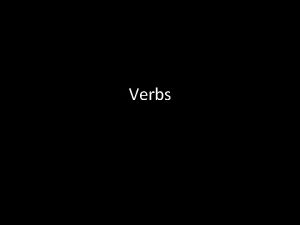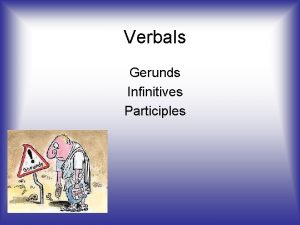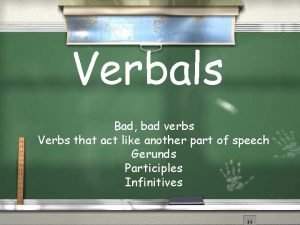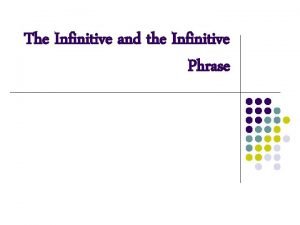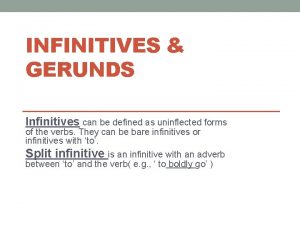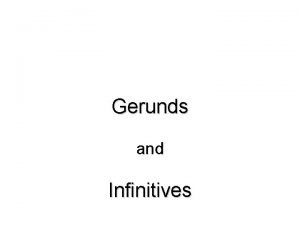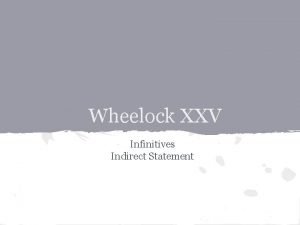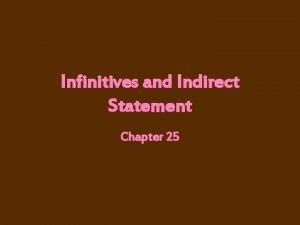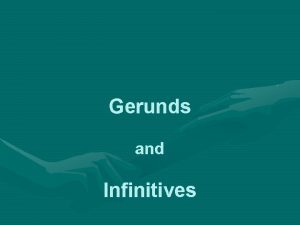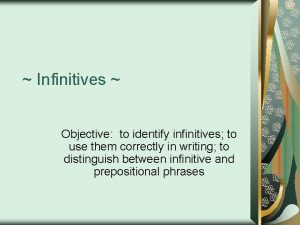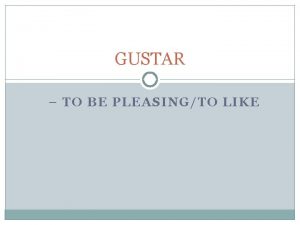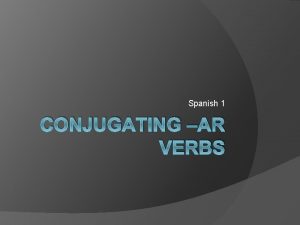Infinitives p 32 are words that are most
























- Slides: 24


Infinitives (p. 32) ___________ are words that are most often used to name ________. The most basic form of a verb is called the ____________. Spanish infinitives are only one word and always end in ______, _____. El infinitivo es…

Negatives (p. 36) To make a sentence negative in Spanish, you usually put ____ in front of the verb or expression. To answer a question negatively you often use the word “no” _____. If you want to say that you don’t like either of two choices, use __________. Contesta la pregunta en una manera negativa: ¿Te gusta bailar y cantar? No, no me gusta ni bailar ni cantar.

Expressing agreement or disagreement (p. 38) To agree with what a person likes, you use _________________. If someone tells you that he/she dislikes something, you can agree by saying ____________. No me gusta bailar. ¿Y a ti? Me gusta bailar. ¿Y a ti?

Adjectives (p. 55) Words that describe people and things are called _________________. In Spanish, most adjectives have both __________ and __________ forms. The masculine form usually ends in the letter ______. And the feminine form usually ends in the letter ________. Adjectives that end in ________ describe both masculine and feminine nouns. Adjectives that end in –dor have a feminine form that ends in ______. gracioso graciosa inteligente trabajadora desordenado desordenada

Definite and Indefinite Articles (p. 60) ____ and _____ are called definite articles and are the equivalent of ______ in English. _____ and ______ are called indefinite articles and are the equivalent of _____ and _____ in English. Escribe el artículo indefinido… y definido. ____ libro ____ chica ____ estudiante perezoso

Word Order (p. 62) In Spanish, _____________ usually come after the noun they describe. Here’s a simple pattern you can follow when writing a sentence in Spanish: __________+___________________+_________ Una frase desordenada…

Subject Pronouns (p. 82) The subject of a sentence tells _____ is doing the action. The subject pronoun _________ people’s names. I= nosotros We (feminine) = nosotras yo You (familiar) = You (formal) = él She = ella He = We (masculine; masculine/feminine)= tú Ud. You (masculine; masculine/feminine)= vosotros You (feminine) = vosotras You (formal)= Uds. They (masculine; masculine/feminine)= ellos They (feminine)= ellas

Tú, _______ , ustedes, and _______ all mean “YOU” Use ______with family, friends, people you age or younger and anyone you call by first name. Use ________ with adults you address with a title. Usted is usually written as _____. In Latin America, use _____when speaking to 2 or more people. In Spain, use __________ when speaking to 2 or more people you call tú individually: TÚ+TÚ=VOSOTROS. Use _______ when talking to 2 or more people you call ____ individually. If a group is made up of males only or of both ________ and ____________ together, use the ____________ forms: nosotros, vosotros, ellos. You can combine a subject pronoun and a _________ to form a subject. EX: ________________________

Present tense of -ar verbs (p. 84) You will want to use verbs in ways other than in the infinitive forms. To do this, you will _______ the –ar from the ____________, leaving the stem. Then you _______ the verb endings to the stem: The verb endings always indicate _____ is doing the action. Subject pronouns are often used for __________________.

Estar (p. 107) Estar is an irregular verb because the ______ form doesn’t follow the regular pattern and because the forms estás, está, and ___________ require __________ marks.

The plurals of nouns and articles (p. 110) To make nouns _________ you usually add –s to words ending in a _________ and –es to words ending in a _________________. The plural definite aritcles are _______ and __________. The plural of indefinite articles are ________ and __________. El reloj La ventana Un lápiz Una carpeta

Looking at the picture below, describe the location of the objects. de la calculadora. El cuaderno está debajo ____ encima del cuaderno. La calculadora está _____ al lado de El disquete está _______la pantalla. detrás de computadora. La bandera está ____la delante de La silla está ______la mesa.

Present tense of –er and –ir verbs (p. 132) Regular –er verbs o es e emos éis en B E BEBO BEBEMOS B BEBES BEBÉIS E BEBEN R

Present tense of –er and –ir verbs (p. 132) o es e escribir escribo Regular –ir verbs imos ís en escribimos escribís escriben escribe

Me gustan, me encantan (p. 135) singular Use me gusta and me encanta to talk about a ____________ noun. gustan encantan Use me_________ and me _______________ to talk about plural nouns. When you use me gusta(n) and me encanta(n) to talk about a el, la, los, las noun, include ____________________________. a a el yogur de fresas. Me encant_____ a el arroz? ¿Te gust_____ an los pasteles! ¡Me encant____ No me gust_____ la clase de matemáticas.

The plural of adjectives (p. 156) s es To make adjective plural, just add an __________ after the vowel at the end of the adjective. If the adjective ends in a consonant, add ________. masculine plural feminine nouns, use the _________________________ When an adjective describes a group including both ___________ and form. The singular form of “mucho” means “much” or “a lot of”, but the plural form muchos _____________ means “many”. os Las verduras son buen______. as El hombre es atrevid______. o Los tomates son sabros______.

Ser (p. 158) to be person Ser, which means ________ is an irregular verb. thing Use ser to describe what a __________ or _________ is like. soy somos eres sois es son Las clases _____ son aburridas. somos amigas. Lola y yo ______ Eres tú desordenado? ¿_____

Ir (p. 180) going To say where someone is ____________, use the verb ir. voy vamos va vais van a To ask where someone is going, use ¿__________? Adónde The verb ir is almost always followed by ____. van ¿Adónde ______ Carmen y Manuel? vais Paco y tú ______ al cine, ¿verdad? van Los chicos _____ a comer ahora.

Asking questions (p. 184) You use _______________ words to ask questions. ¿Qué? ¿Adónde? ¿Cómo? ¿De dónde? ¿Quién? ¿Cuál? ¿Con quién? ¿Por qué? ¿Dónde? ¿Cuándo? ¿Cuántos? When? How many? With whom? To where? Where? How? What? Which? What? From where? Who? Why? What?

In Spanish, when you ask a question with an interrogative word you put the subject accent mark. interrogative words have a written _________ verb _________ before the ____________. Notice that all 1. ¿Cómo estás? Estoy muy bien. 2. ¿Adónde vas el viernes? Voy al cine. 3. ¿Con quién vas al cine? Voy con Lola. 4. ¿A qué hora vas al cine? Voy a las 8 de la noche.

Ir + a + infinitive (p. 206) Just as you use “going” + an infinitive in English to say what you are going to do, in Spanish you ir use a form of the verb ____________ to express the same thing. Say what each person is going to do (use IR + A + INFIN. ) : 1. Pedro 2. Yo 3. Ellas 4. Nosotros Va a montar en monopatín. Voy a cantar. Van a estudiar. Vamos a bailar.

Jugar (p. 208) playing Use the verb jugar to talk about ________________ a sport or a game. Stem-changing verb: Even though “jugar” uses the same endings as the other –ar verbs, it has a different stem in some forms. For those forms, the –u becomes -ue _____________. juego jugamos juegas jugáis juegan

¡JUGAR! Juegan ellos al vóleibol? 1. ¿_____ juegas al golf muy bien. 2. Tú no ______ jugamos al fútbol. 3. Los chicos y yo______ Juega Paco al hockey? 4. ¿ _____
 Insidan region jh
Insidan region jh Phân độ lown ngoại tâm thu
Phân độ lown ngoại tâm thu Block nhĩ thất cấp 1
Block nhĩ thất cấp 1 Thể thơ truyền thống
Thể thơ truyền thống Thơ thất ngôn tứ tuyệt đường luật
Thơ thất ngôn tứ tuyệt đường luật Chiến lược kinh doanh quốc tế của walmart
Chiến lược kinh doanh quốc tế của walmart Tìm vết của mặt phẳng
Tìm vết của mặt phẳng Hãy nói thật ít để làm được nhiều
Hãy nói thật ít để làm được nhiều Tôn thất thuyết là ai
Tôn thất thuyết là ai Gây tê cơ vuông thắt lưng
Gây tê cơ vuông thắt lưng Sau thất bại ở hồ điển triệt
Sau thất bại ở hồ điển triệt Infinitives latin
Infinitives latin Dangling participle
Dangling participle Bad verbs
Bad verbs Modals with passive voice
Modals with passive voice Infinitives as adverbs
Infinitives as adverbs Past simple seem
Past simple seem Complex gerunds and infinitives
Complex gerunds and infinitives Function of an infinitive
Function of an infinitive Gerunds infinitives and participles are types of
Gerunds infinitives and participles are types of Songs with infinitives and gerunds
Songs with infinitives and gerunds Stories with gerunds and infinitives
Stories with gerunds and infinitives Esl gerunds and infinitives
Esl gerunds and infinitives Dangling infinitives
Dangling infinitives 12 infinitives
12 infinitives











